The Catholic Pilgrimage to Holywell, Flintshire
The Catholic pilgrimage to Holywell includes
bathing in the holy well, a visit to the national shrine
of St Padre Pio, and concludes with a splendid High Mass
in the Traditional Roman Rite
If you wish to register your interest
and receive information by mail about the next pilgrimage
then please click here.
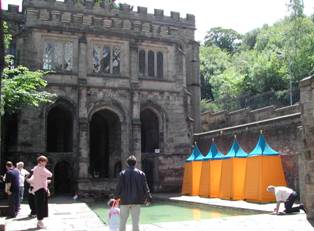
The Beautiful Unspoilt Shrine
On the 1st Sunday of July every year, thousands of Catholics
descend upon the beautiful shrine St Winefride’s
Well in Holywell, Flint, North Wales. What brings them
back to this pilgrimage spot year after year?
In the first half of the seventh century, where Holywell
now stands, there lived the girl who is today famous
as Saint Winefride. For a long time after her
death her fame was merely local; it was part of the greater
fame of her uncle, Saint Beuno, the most famous of the
saints of North Wales.
In 1138 relics of St Winefride were translated to Shrewsbury,
and she became the patron saint of that town. Her
relics were venerated there by pilgrims until the dissolution
of the monasteries by Henry VIII. Her shrine and
its relics were then destroyed on the orders of the Government. One
finger-bone was saved, half of which is today preserved
at Holywell, while the other half is in the possession
of the Catholic Church at Shrewsbury.
The Legend
Winefride was the daughter of a local prince. One
day Caradoc, a chieftain from Hawarden, attempted to
seduce Winefride. She ran from him towards the
church built by her uncle St Beuno. Caradoc pursued
her and cut off her head. In the place where her
head fell a spring of water came forth. St. Beuno
came out from the church, took up her head and placed
it back on her body. He then prayed and raised
her to life. A white scar encircled her neck,
witness to her martyrdom. St Beuno then laid a
malediction on Caradoc who sank into the ground and was
never seen again. Winefride subsequently became
a nun and joined a community where she became the Abbess. While
this legend may seem essentially unbelievable, it is
nevertheless based upon real people and real events.
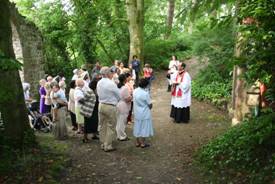
Pilgrims making the Way of the Cross at nearby
Pantasath
The Government, however, proved powerless to put a stop
to the pilgrimages to her well, which became the center
of Welsh Catholic resistance to the Protestant ascendancy
and oppression and has links with a number of the English
and Welsh martyrs. Alone of all the Pilgrimages
in Wales it has continued unbroken down to the present
day. Nothing was able to stop it. It links
modern Wales through her mediaeval past with the Age
of the Saints and the founding of the Welsh nation.
Indeed, so valuable were the offerings at Holywell that
the chapel was not destroyed by Henry VIII but leased
to a Protestant, one William Holcroft. There is an
amusing account of Mr Holcroth complaining that certain “bold
Catholics” were entering the well-chapel with collecting
boxes shouting: “Put your money in here where it
shall do good to your souls; if you put it into the regular
collection box, it will go to the King and shall not benefit
you”.
Famous Pilgrims
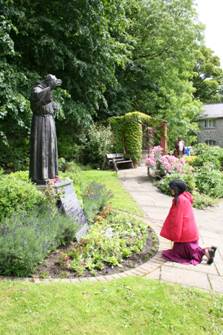
A Pilgrim Praying at the Nearby
National
Shrine of St Padre Pio
It is against a background of a crowded and popular pilgrimage
spot that we should visualize the long list of famous men
and women who came to Holywell.
Henry V is reported to have walked bare foot from Shrewsbury
in 1416. This was the year he was preparing for
his second and greater invasion of France that followed
the Agincourt campaign. I like to imagine that
he also came to do penance for the number of French prisoners
whom he had ordered murdered in cold blood following
the battle of Agincourt.
Edward IV made a pilgrimage to Holywell, which was
a stronghold of the Yorkist cause at the time. Richard
III gave alms to maintain a priest at the well, and Henry
Tudor, came in secret to the neighborhood to take counsel
with his allies. It was Henry's mother, the Lady
Margaret, who played a large part in the construction of
the present chapel, and Caxton's Life of the Saint Winefride
may well be due to Lady Margaret’s influence.
Saint Winefride is among the saints placed to watch for
ever over the tomb of the first Welsh King of England,
Henry VII's, in his chapel at Westminster.
The last King to come on pilgrimage was James II, who
came on 29 August 1686 with his Queen, Mary of Modena,
to pray for a Stuart Prince of Wales. Mary of Modena's
gave to Saint Winefride's shrine part of the shift, which
Mary Queen of Scots had worn at her execution. A
son, James Edward, was born less than two years later.
The Wales of Saint Winefride
We know a surprising amount about the Wales in which
Saint Winefride lived. It was a world in which the civilization
of Rome, which still loomed large in men's minds and memories,
had passed. It was an age of violent transition. In
Wales this crisis was met and mastered by the Welsh Saints.
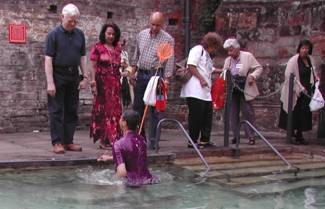
A Pilgrim Bathing in the Holy Well
Saint Winefride lived in a Wales composed of a number
of small kingdoms ruled by hereditary kings, a state
of affairs which bridged the period between the departure
of the Roman armies and the gradual unification of the
country in the ninth century. These rulers thought
of themselves as carrying on the traditions of the late
Roman Empire, and they were in touch with Gaul by means
of the old sea routes and consequently with what was happening
on the Continent. Undoubtedly, travel was slow and
communications uncertain, but we shall be making a great
mistake if we think of these men as savage chieftains. Instead,
we must think of them as proud, energetic, and masterful
men, conscious that their dynasties had turned back the
Irish invasion of the Welsh coastline, and stabilized their
position in post-Roman Wales. They had now to consider
the threat from the East, where the pagan kingdoms set
up by the leaders of the war-bands of Saxons and Angles
had become powerful. Saint Beuno was the leader of
a mission into North-West Wales, playing a similar role
in North Wales as did Saint David in the South. At
a time when the wave of pagan invasion was eating its
way forward to the Eastern borderlands, he established
Catholicism in a framework of fortified monastic settlements.
Saint Beuno was clearly a notable example of the Catholic
principle that grace does not destroy, but perfects nature. As
one reads the traditional story of how he rebuked the
formidable prince Cadwallon, or laid his malediction
on Caradoc, the man who had attacked his niece at Holywell,
one is irresistibly reminded of an early account of how
the Welshmen of his own day were remarkable for a "boldness and confidence
in speaking and answering, even in the presence of their
Princes and Chieftains." St Beuno
was a monk, a master of monks, a patriot, a challenger
of tyrants, a principal founding father of his nation
and is one of the greatest of the saints of Wales.
A Welsh Nun in the Age of the Saints
And what of Saint Beuno's niece? Of Saint Winefride's
life as a nun it is possible to have a reasonably clear
impression. Today, when we think of a girl becoming
a nun, we naturally think of a sharp break between her
life "in the world" and her life when, she enters
a convent. Among the Celtic nations, however, women
often began their life as religious within their own families. Subsequently,
as and when the opportunity offered, they joined a religious
community.
The working day of a Celtic nun was exceedingly arduous. Apart
from the Mass and the Psalter that, then as now, provided
the framework of the day; apart from the long, slogging,
disciplined task of prayer, there was an immense burden
of work to be carried and completed. There was the
labour of the morning and evening milking, the churn, the
bread making, and the slow, heavy work of grinding the
corn. The nuns had to be, to all intents and purposes,
self-supporting and, into the bargain, there were the poor
and the travelers to be cared for and entertained. Saint
Winefride must have known all the problems of sheep-rearing,
harvesting, the dairy, the larder, and the bake house,
and especially the task of stretching slender resources
to meet never-ending need.
Then again, it was largely upon the nuns, as they toiled
at the loom, at the vat, and with the needle, that the
churches, monasteries, and mission-stations depended for
vestments, altar coverings, and wall hangings.
Hospitality
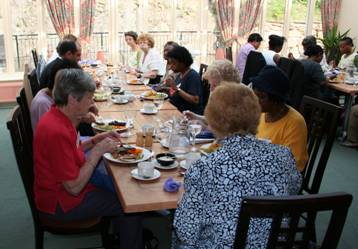
Pilgrims Enjoying Sharing a Meal Together
It is important to appreciate the position which was
held by women in the Wales of Saint Winefride's day,
a position that is clearly reflected, not only in literature,
but in Welsh law of that time. For the social tradition
in which she was raised provides the necessary means of
seeing her story in focus. In particular, it provides
the authentic context for the story of her encounter
with Caradoc.
The position of women in Wales, as compared with most
other countries of Europe, was one of very real dignity. A
woman could not be forced to marry against her will. When
she came of age, she was entitled by law to a share in
her father's movable property, equal to half her brother's. On
marriage she was entitled to a dowry from her father; she
had of legal right a definite and substantial share in
her husband's goods. Nor could she normally be struck
by her husband. Her legal worth, which fixed the
standard of compensation if she was killed or injured,
was six times greater in Wales than among the Anglo-Saxons. Thus
Saint Winefride grew up in a society in which she enjoyed
a position of assured dignity in virtue of her womanhood. Further,
that she came of noble stock is almost certain.
Much of St Winefride’s time as a girl would have
been spent in helping her mother and the other women of
the household in the exacting duties of hospitality. This
business of hospitality was an important feature of Welsh
society, and it remained so for centuries to come.
A famous Description of Wales In the twelfth century
has this to say: "No one of this nation ever begs,
for the houses of all are common to all; and they consider
kindness and hospitality amongst the highest virtues. So
much does hospitality here rejoice in communication, that
it is neither offered nor requested by travelers, who,
on entering any house, merely deliver up their arms. When
water is offered to them, if they allow their feet to be
washed, they are received as guests; for the offer to wash
the feet is, with this nation, an invitation to accept
hospitality. But if they refuse the proffered service,
they only wish for morning refreshment, not lodging.
The young men move about in troops and armed bands,
each under the direction of a chosen leader ever ready
to defend their country. And so, also, they have
free admittance into every house as if it were their
own. But, as for those who arrive in the morning,
they are entertained till evening with the conversation
of the young women, and the music of the harp, for each
house has young women and harps allotted to this purpose. In
each family the art of playing on the harp is held higher
in esteem than any other learning or skill.
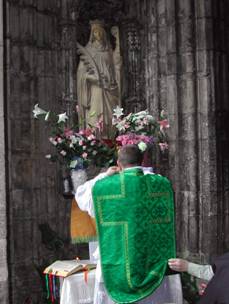
Traditional Mass in the Shrine
In the evening, when no more guests are expected,
the meal is prepared according to the number and dignity
of the guests, and resources of the household. Although
the whole family is engaged in waiting on the guests,
the host and the hostess remain standing, paying unremitting
attention to everything, and they take no food themselves
until everyone has eaten his fill, so that any lack may
fall upon them."
This is a passage which deserves careful study if we
wish to understand the story of Saint Winefride. For
this tradition of hospitality goes right back to the very
beginnings of Welsh literature, thirteen hundred years
ago; as also does the war-bands of young men, undergoing
what we would nowadays call "battle-training" in
the mountains and forests, and then coming weary and hungry
to claim hospitality. It was part of the essential
framework on which the whole Welsh way of life depended.
Furthermore, it depended primarily on the lady of the
house, her daughters and the womenfolk, and without the
assured position which law and culture alike accorded
to them, it would have been impossible. This position
necessarily involved a high standard of breeding and chivalry
among the men who claimed hospitality. Against this
background, the attempt by Caradoc to seduce St Winefride,
a deliberate yet casual insult to the house in which he
was seeking hospitality, would have been an unspeakable
and absolute abomination to the Welsh of St Winefride’s
time. It struck right to the heart of that tradition
of Catholic generosity and hospitality which was the crowning
glory of the society that it was Caradoc’s inherited
duty to protect.
His fellow nobleman, especially those with blood ties
to St Winefride, would have seen it as their sacred duty
to hunt down and slay Caradoc like a dog. So it
is very probable that he would not have survived St Beuno’s
malediction by very long, which would account for the
legend that the ground swallowed him up: in a very real
sense, it would have done.
NOVENA PILGRIMAGE PRAYER TO ST. WINEFRIDE
Almighty and everlasting God, Who didst enrich St. Winefride
with the gift of Virginity, grant us we beseech Thee by
her intercession to set aside the delights of the world,
and to obtain with her the throne of everlasting glory,
through Christ Our Lord. Amen.
Almighty and everlasting God, grant we humbly beseech
Thee, that St. Winefride may obtain for us such spiritual
and temporal benefits as are expedient to Thy holy service
and our eternal salvation, through Christ our Lord. Amen.
PILGRIMAGE TRADITIONS
Recite the Station or Special Pilgrimage
Prayer
1. Make the sign of the cross at entrance.
2. Proceed to the front of the Well and make your
intentions.
3. Recite the Apostles creed.
4. Recite one decade of the rosary while walking
round the Well or the Pool. |
If you wish to register your interest
and receive information by mail about the next pilgrimage
then please click here.
|
The classic "A Morbid Taste For Bones" (Book 1 in the Cadfael Chronicles) by Ellis Peters is based on the story of St Winefride
|
